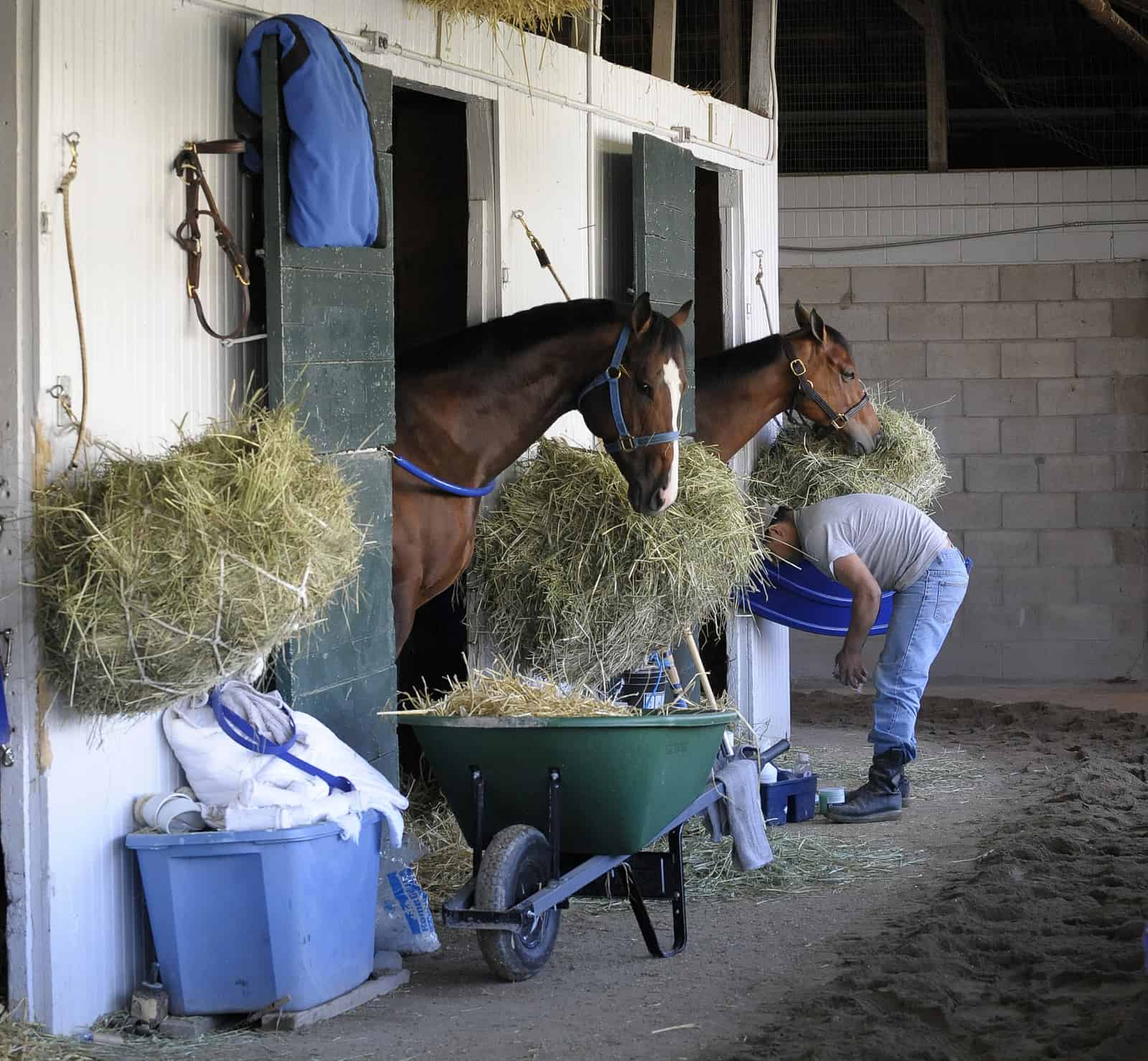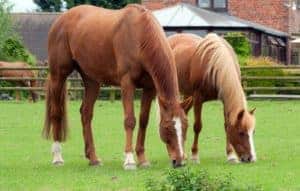Feeding Racehorses With the Digestive Tract in Mind

At the seventh Welfare and Safety of the Racehorse Summit, held June 28 at the Keeneland Race Course, in Lexington, Kentucky, Bob Coleman, PhD, and Laurie Lawrence, PhD, reviewed the equine digestive tract and how to keep it healthy while providing the racehorse the fuel he needs to perform at the top of his game. Coleman is an associate professor and Extension horse specialist at the University of Kentucky (UK), in Lexington, and Lawrence is a professor in the UK Department of Animal and Food Sciences.
Racehorses need dietary energy to perform, but they also need a healthy digestive tract. The challenge comes with the fact that, to obtain the energy, many racehorses consume large amounts of food in just two meals per day. Horses evolved to graze almost continuously throughout the day, resulting in a steady stream of digesta migrating through the gastrointestinal (GI) tract. As such, eating fewer, larger meals can increase the risk of gastric ulcers and other forms of digestive upset, which can diminish performance.
For that reason, it’s important to focus a feeding program on maintaining a normal gastrointestinal tract as well as meeting nutrient needs, Lawrence said.
GI Tract Anatomy
The horse’s GI tract begins with his mouth, Lawrence said, where the lips select feed, the teeth reduce particle size (making the nutrients more accessible to digestive enzymes), and the saliva wets the feed. Horses’ saliva—which the horse produces when he chews—also contains buffers that, when swallowed, help protect the stomach’s sensitive lining from the acid produces continually. That acid can cause gastric ulcers to develop when not buffered properly.

The stomach—food’s next stop in the GI tract—is small compared to the horse’s body size and is divided into two sections: the upper nonglandular portion and the lower glandular portion. Stomach acid is secreted in the glandular portion, which is coated with a protective mucus and bicarbonate layer. The nonglandular portion has less protection from mucus and bicarbonate, making it more prone to gastric ulcer development. The buffering saliva can help protect the nonglandular portion, but only if the horse is chewing.
Next up on food’s journey through the GI tract is the small intestine. Lawrence said the small intestine in where enzymatic digestion of protein, fats, and starch occurs, but with some limitations. Starch—a storage carbohydrate in grains and seeds that’s high in energy—is well-digested in small amounts. When horses ingest larger amounts, however, the small intestine’s digestive efficacy decreases, she said. When starch digestive efficacy decreases, the horse loses out on useful calories in the food he consumes—a problem for racehorses that expend many calories in racing and training. Lawrence also noted that certain starches are more digestible than others—choosing grains that have been ground or processed can improve digestion.
Next up, Lawrence said, is the large intestine (or hindgut), where a diverse microbial ecosystem ferments fiber (such as hay and grass). Any starch that went undigested in the small intestine also passes to the large intestine. While starch can be fermented, she said, there are issues that can arise, including a reduction in large intestine pH and changes in the hindgut’s microbial community. Both can reduce digestive efficiency. Lawrence also mentioned that a normal microbial community in the gastrointestinal tract is important for defense against pathogens that can result in digestive disorders.
Designing the Diet
Now that we’ve made our way through the GI tract, it’s time to design a feeding program with it in mind. The two main considerations, Coleman said, are:
- What nutrients does the horse need?
- How will they be supplied?
The nutrient needs are fairly simple, Coleman said:
The amount of nutrients a horse needs depends on his workload. Nutritionists typically group workloads into five basic categories:
- Maintenance (Coleman said these are the “lawn ornaments” that don’t do much, but need to maintain their weight day-to-day);
- Light work (typically pleasure horses or “weekend warriors”);
- Moderate work (a school horse, for example);
- Heavy work (a show horse or lower-level sport horse); and
- Intense work (the high-performance horses—racehorses, endurance horses, upper-level eventing horses, etc.).
“Not surprisingly,” Coleman said, “as workload increases, so does calorie/nutrient requirement.”
But, he stressed, diets should always be forage-based.
For horses with lower intensity workloads, a diet consisting of mostly forage and some, if any, concentrate might meet their nutrient requirements. A horse in high-intensity work, however, will likely require a diet still based on good-quality forage, but with a larger amount of concentrate.
Coleman said hay—regardless of the type—should be free of mold and dust. Hay being fed to high-performance horses, like racehorses, should have a high nutrient content (such hay might be less appropriate for a very easy keeper or a horse needs to lose weight) and be palatable.
When it comes to concentrates, Coleman said he recommends using commercially produced feeds formulated for racehorses. These products, he said, are designed with racehorses in mind, take advantage of current research on performance horse nutrition, and are fortified with the vitamins and minerals these horses need to succeed. Coleman stressed that these products need to be fed at the recommended feeding rate to ensure the horse receives all the nutrients he needs.
Coleman said supplemental feeds—such as fats, oils, and supplements—can also benefit some horses.
So how much feed does it take to meet a horse’s nutrient requirements? Coleman said an average racehorse in intense work might require as much as 16 pounds of hay and 14 pounds of concentrate per day. It all depends on how much the horse weighs and how much work he’s doing.
He stressed the importance of planning the feeding schedule around what the horse needs—spread concentrates out into several small feedings throughout the day, and avoid lumping it into one large concentrate meal.
Lawrence also gave some feeding recommendations to help promote GI health without sacrificing calories:
- Replace some starch with fat—Fat has twice as many calories as starch and is well-digested in the horse’s system, but she noted that palatability can be an issue for some horses;
- Replace some starch with fiber—Adding beet pulp, soybean hulls, and other high-calorie fiber sources can help increase chewing time and, thus, saliva production; and
- Use starches that are well-digested in the small intestine—The more efficient the digestion, the less you’ll have to feed and the lower the risk of starch reaching the large intestine where it can cause digestive upset.
Take-Home Message
Regardless of what kind of horse you’re feeding, strive to maintain normal GI function and health. Base your horse’s diet on forage, add concentrate as needed, and choose your feeds carefully. The end result will be a healthy horse performing at his best.

Written by:
Erica Larson
Related Articles
Stay on top of the most recent Horse Health news with















